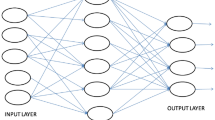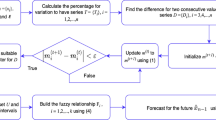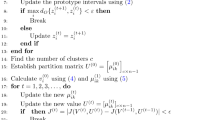Abstract
Inspired by how some cognitive abilities affect the human decision-making process, the proposed approach combines neural networks with type-2 fuzzy systems. The proposal consists of combining computational models of artificial neural networks and fuzzy systems to perform clustering and prediction of time series corresponding to the population, urban population, particulate matter (PM2.5), carbon dioxide (CO2), registered cases and deaths from COVID-19 for certain countries. The objective is to associate these variables by country based on the identification of similarities in the historical information for each variable. The hybrid approach consists of computationally simulating the behavior of cognitive functions in the human brain in the decision-making process by using different types of neural models and interval type-2 fuzzy logic for combining their outputs. Simulation results show the advantages of the proposed approach, because starting from an input data set, the artificial neural networks are responsible for clustering and predicting values of multiple time series, and later a set of fuzzy inference systems perform the integration of these results, which the user can then utilize as a support tool for decision-making with uncertainty.

























Similar content being viewed by others
Explore related subjects
Discover the latest articles and news from researchers in related subjects, suggested using machine learning.References
Sfetsos, A., Siriopoulos, C.: Combinatorial time series forecasting based on clustering algorithms and neural networks. Neural Comput. Appl. 13, 56–64 (2004). https://doi.org/10.1007/s00521-003-0391-y
Li, Y., Bao, T., Gong, J., Shu, X., Zhang, K.: The prediction of dam displacement time series using STL, extra-trees, and stacked LSTM neural network. IEEE Access 8, 94440–94452 (2020). https://doi.org/10.1109/ACCESS.2020.2995592
Chacón, H., Kesici, E., Najafirad, P.: Improving financial time series prediction accuracy using ensemble empirical mode decomposition and recurrent neural networks. IEEE Access 8, 117133–117145 (2020). https://doi.org/10.1109/ACCESS.2020.2996981
Hu, Y., Sun, X., Nie, X., Li, Y., Liu, L.: An enhanced LSTM for trend following of time series. IEEE Access 7, 34020–34030 (2019). https://doi.org/10.1109/ACCESS.2019.2896621
Moghar, A., Hamiche, M.: Stock Market Prediction Using LSTM Recurrent Neural Network, in: Procedia Computer Science, vol. 170, 2020, pp. 1168–1173. https://doi.org/10.1016/j.procs.2020.03.049.
Cherif, A., Cardot, H., Boné, R.: SOM time series clustering and prediction with recurrent neural networks. Neurocomputing 74(11), 1936–1944 (2011). https://doi.org/10.1016/j.neucom.2010.11.026
Mendez, E., Lugo, O., Melin, P.A.: Competitive modular neural network for long-term time series forecasting. In: Melin P., Castillo O., Kacprzyk J. (eds) Nature-Inspired Design of Hybrid Intelligent Systems, Studies in Computational Intelligence, vol 667. Springer, 2012, pp. 243–254, https://doi.org/10.1007/978-3-319-47054-2_16
Jang, J.-S.R.: Fuzzy Inference Systems. In: Neuro-fuzzy and soft computing: a computational approach to learning and machine Intelligence, Prentice Hall, Upper Saddle River 07458, 1997, pp. 73–90
Orakcı, S.: Exploring the relationships between cognitive flexibility, learner autonomy, and reflective thinking. Think. Skills Creat. 41(2021), 100838 (2021). https://doi.org/10.1016/j.tsc.2021.100838
Howlett, C., et al.: Same room - different windows? A systematic review and meta-analysis of the relationship between self-report and neuropsychological tests of cognitive flexibility in healthy adults. Clin. Psychol. Rev. 88, 102061 (2021). https://doi.org/10.1016/j.cpr.2021.102061
Dheer, R., Lenartowicz, L.: Cognitive flexibility: impact on entrepreneurial intentions. J. Vocat. Behav. 115, 103339 (2019). https://doi.org/10.1016/j.jvb.2019.103339
Melin, P., Monica, J.C., Sanchez, D., Castillo, O.: Analysis of spatial spread relationships of Coronavirus (COVID-19) pandemic in the world using Self Organizing maps. Chaos, Solitons Fractals 138, 109917 (2020). https://doi.org/10.1016/j.chaos.2020.109917
Valdez, F., Melin, P., Castillo, O.: Modular Neural Networks architecture optimization with a new nature inspired method using a fuzzy combination of Particle Swarm Optimization and Genetic Algorithms. Inf. Sci. 270, 143–153 (2014). https://doi.org/10.1016/j.ins.2014.02.091
Castillo, O., Melin, P.: Hybrid intelligent systems for time series prediction using neural networks, fuzzy logic, and fractal theory. IEEE Trans. Neural Netw. 13(6), 1395–1408 (2002). https://doi.org/10.1109/TNN.2002.804316
Melin, P.: Introduction to type-2 fuzzy logic in neural pattern recognition systems, In: Modular Neural Networks and Type-2 Fuzzy Systems for Pattern Recognition, Studies in Computational Intelligence, vol 389. Springer, Berlin, 2012, pp. 3–6, https://doi.org/10.1007/978-3-642-24139-0_1
Sanchez, D., Melin, P.: Modular neural networks for time series prediction using type-1 fuzzy logic integration. In: Melin, P., Castillo, O., Kacprzyk, J. (eds.) Design of Intelligent Systems Based on Fuzzy Logic, Neural Networks and Nature-Inspired Optimization, pp. 141–154. Studies in Computational Intelligence, Springer, Cham. (2015)
Melin, P., Mancilla, A., Lopez, M., Mendoza, O.: A hybrid modular neural network architecture with fuzzy sugeno integration for time series forecasting. Appl. Soft Comput. J. 7(4), 1217–1226 (2007). https://doi.org/10.1016/j.asoc.2006.01.009
Kannoth, S., Kandula, S., Shaman, J.: The association between early country-level COVID-19 testing capacity and later COVID-19 mortality outcomes. Influenza Other Respir. Viruses Open Access 16(1), 56–62 (2022). https://doi.org/10.1111/irv.12906
Jiang, M., Amponsah, N.: Promoting mask-wearing in COVID-19 Brand Communications: effects of gain-loss frames self- or other-interest appeals, and perceived risks. J. Advert. 50(3), 271–279 (2021). https://doi.org/10.1080/00913367.2021.1925605
Guo, Y., Kaniuka, A., Sims, J.: An Epidemiologic Analysis of Associations between County-Level Per Capita Income, Unemployment Rate, and COVID-19 Vaccination Rates in the United States. Int. J. Environ. Res. Public Health 19, 1755 (2022). https://doi.org/10.3390/ijerph19031755
Chang-Xing, L.A., et al.: Critical analysis of SARS-CoV-2 (COVID-19) complexities, emerging variants, and therapeutic interventions and vaccination strategies. Biomed. Pharmacother. 146, 112550 (2022). https://doi.org/10.1016/j.biopha.2021.112550
Melin, P., Castillo, O.: Spatial and temporal spread of the COVID-19 pandemic using self organizing neural networks and a fuzzy fractal approach. Sustainability 13, 8295 (2021). https://doi.org/10.3390/su13158295
Castillo, O., Melin, P.: Forecasting of COVID-19 time series for countries in the world based on a hybrid approach combining the fractal dimension and fuzzy logic. Chaos Solitons Fractals (2020). https://doi.org/10.1016/j.chaos.2020.110242
Melin, P., Monica, J.C., Sanchez, D., Castillo, O.: Multiple ensemble neural network models with fuzzy response aggregation for predicting COVID-19 time series: the case of Mexico. Healthcare. 8(2), 181 (2020). https://doi.org/10.3390/healthcare8020181
Melin, P., Monica, J.C., Sanchez, D., Castillo, O.: A new prediction approach of the COVID-19 virus pandemic behavior with a hybrid ensemble modular nonlinear autoregressive neural network. Soft. Comput. (2020). https://doi.org/10.1007/s00500-020-05452-z
WHO global air quality guidelines: particulate matter (PM2.5 and PM10), ozone, nitrogen dioxide, sulfur dioxide and carbon monoxide. Executive summary, Geneva: World Health Organization, 2021, pp. 1–16, https://apps.who.int/iris/handle/10665/345334
Ovchynnikova, O., Belovsky. C., Khan, O.: Neural network forecasting of international population migration, 2021 11th International Conference on Advanced Computer Information Technologies (ACIT), 2021, pp. 147–152, doi: https://doi.org/10.1109/ACIT52158.2021.9548420
Levantesi, S., Nigri, A., Piscopo, G.: Clustering-based simultaneous forecasting of life expectancy time series through Long-Short Term Memory Neural Networks. Int. J. Approx. Reason. 140, 282–297 (2022). https://doi.org/10.1016/j.ijar.2021.10.008
Tsai, Y., Zeng, Y., Chang, Y.: Air pollution forecasting using RNN with LSTM, 2018 IEEE 16th Intl Conf on Dependable, Autonomic and Secure Computing, 16th Intl Conf on Pervasive Intelligence and Computing, 4th Intl Conf on Big Data Intelligence and Computing and Cyber Science and Technology Congress(DASC/PiCom/DataCom/CyberSciTech), 2018, pp. 1074–1079, doi: https://doi.org/10.1109/DASC/PiCom/DataCom/CyberSciTec.2018.00178.
Austin, E., Coull, B., Zanobetti, A., Koutrakis, P.: A framework to spatially cluster air pollution monitoring sites in US based on the PM2.5 composition. Environ. Int. 59, 244–254 (2013). https://doi.org/10.1016/j.envint.2013.06.003
Arun-Kumar, K.E., et al.: Comparative analysis of Gated Recurrent Units (GRU), long Short-Term memory (LSTM) cells, autoregressive Integrated moving average (ARIMA), seasonal autoregressive Integrated moving average (SARIMA) for forecasting COVID-19 trends. Alexandria Eng. J. 61(10), 7585–7603 (2022). https://doi.org/10.1016/j.aej.2022.01.011
Parasyris, A., Alexandrakis, G., Kozyrakis, G.V., Spanoudaki, K., Kampanis, N.A.: Predicting meteorological variables on local level with SARIMA, LSTM and hybrid techniques. Atmosphere 13(6), 878 (2022). https://doi.org/10.3390/atmos13060878
Wasesa, M., et al.: SARIMA and artificial neural network models for forecasting electricity consumption of a microgrid based educational building. IEEE Int. Conf. Ind. Eng. Eng. Manag. (IEEM) 2020, 210–214 (2020). https://doi.org/10.1109/IEEM45057.2020.9309943
Ding, X., Hao, K., Cai, X., Tang, S., Chen, L., Zhang, H.: A novel similarity measurement and clustering framework for time series based on convolution neural networks. IEEE Access 8, 173158–173168 (2020). https://doi.org/10.1109/ACCESS.2020.3025048
Barbounis, T.G., Theocharis, J.B.: Locally recurrent neural networks for wind speed prediction using spatial correlation. Inform. Sci. 177(24), 5775–5797 (2007). https://doi.org/10.1016/j.ins.2007.05.024
Kohonen T.: Self-Organizing Feature Maps. In: Self-Organization and Associative Memory. Springer Series in Information Sciences, vol 8. Springer, Berlin, Heidelberg, 1988, pp. 127–136, https://doi.org/10.1007/978-3-662-00784-6_5
Xu, M., Song, R., Zhao, Y,. Song, B., Tang, J.: Application of NARX dynamic neural network in blood glucose prediction model, 2020 IEEE 9th Data Driven Control and Learning Systems Conference (DDCLS), 2020, pp. 178–183, doi: https://doi.org/10.1109/DDCLS49620.2020.9275222.
Mónica, J.C., Melin, P., Sánchez, D.: Genetic Optimization of Ensemble Neural Network Architectures for Prediction of COVID-19 Confirmed and Death Cases. In: Castillo O., Melin P. (eds) Fuzzy Logic Hybrid Extensions of Neural and Optimization Algorithms: Theory and Applications. Studies in Computational Intelligence, vol 940. Springer, Cham., 2021, pp. 85–98, https://doi.org/10.1007/978-3-030-68776-2_5
Castillo, O., Melin, P.: 3 type-2 fuzzy logic. In: Type-2 Fuzzy Logic: Theory and Applications. Studies in Fuzziness and Soft Computing, vol 223. Springer, Berlin 2007, pp. 29–43
Melin, P., Ontiveros-Robles, E., Castillo, O.: Background and Theory. In: New Medical Diagnosis Models Based on Generalized Type-2 Fuzzy Logic. SpringerBriefs in Applied Sciences and Technology. Springer, Cham, 2021, pp. 5–28,
Ontiveros-Robles, E., Castillo, O., Melin, P.: Towards asymmetric uncertainty modeling in designing General Type-2 Fuzzy classifiers for medical diagnosis. Expert Syst. Appl. 183, 115370 (2021). https://doi.org/10.1016/j.eswa.2021.115370
Ritchie, H. et al.: Coronavirus Pandemic (COVID-19). Published online at OurWorldInData.org. Retrieved from: https://ourworldindata.org/coronavirus
The World Bank Data: Population, total, 2022. Retrieved from: https://data.worldbank.org/indicator/SP.POP.TOTL
The World Bank Data: Urban population, 2022. Retrieved from: https://data.worldbank.org/indicator/SP.URB.TOTL
The World Bank Data: PM2.5 air pollution, mean annual exposure (micrograms per cubic meter), 2022. Retrieved from: https://data.worldbank.org/indicator/EN.ATM.PM25.MC.M3
The World Bank Data: CO2 emissions (kt), 2022. Retrieved from: https://data.worldbank.org/indicator/EN.ATM.CO2E.KT
Author information
Authors and Affiliations
Corresponding author
Rights and permissions
Springer Nature or its licensor (e.g. a society or other partner) holds exclusive rights to this article under a publishing agreement with the author(s) or other rightsholder(s); author self-archiving of the accepted manuscript version of this article is solely governed by the terms of such publishing agreement and applicable law.
About this article
Cite this article
Ramírez, M., Melin, P. A New Interval Type-2 Fuzzy Aggregation Approach for Combining Multiple Neural Networks in Clustering and Prediction of Time Series. Int. J. Fuzzy Syst. 25, 1077–1104 (2023). https://doi.org/10.1007/s40815-022-01426-5
Received:
Revised:
Accepted:
Published:
Issue Date:
DOI: https://doi.org/10.1007/s40815-022-01426-5




